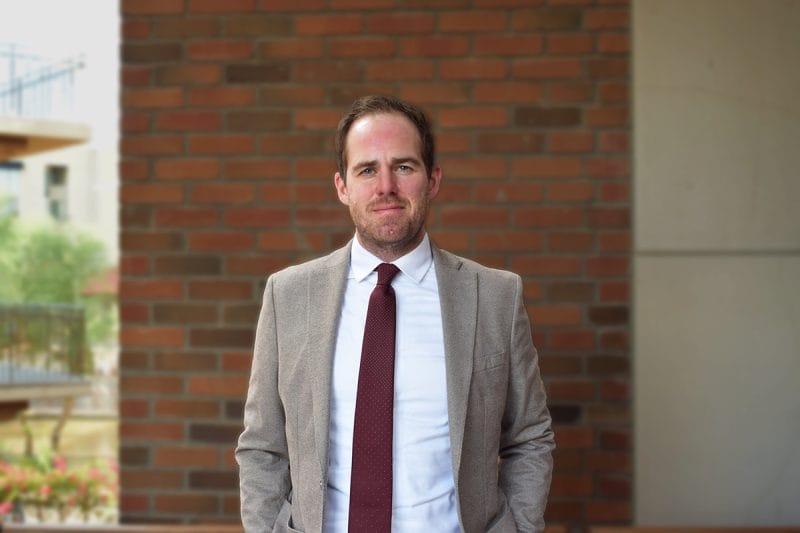Expertise in ‘Horizontal BIM’ Drives Industry Innovation While Adding Value for Clients
 Sundt is a recognized expert in the application of building information modeling (BIM) to vertical construction projects, and now the company is transferring lessons learned in vertical BIM tohorizontal infrastructure projects like highways and bridges. Two Sundt employees, Modeling Engineer Eric Cylwik and Kevin Dwyer, Senior Claims Coordinator, wrote articles about Sundt’s pioneering use of horizontal BIM – called virtual design in construction, or VDC – that were published in a recent edition of ENR magazine and online at CENews.com. The articles explain the company’s innovative approach and how it’s benefitting clients.
Sundt is a recognized expert in the application of building information modeling (BIM) to vertical construction projects, and now the company is transferring lessons learned in vertical BIM tohorizontal infrastructure projects like highways and bridges. Two Sundt employees, Modeling Engineer Eric Cylwik and Kevin Dwyer, Senior Claims Coordinator, wrote articles about Sundt’s pioneering use of horizontal BIM – called virtual design in construction, or VDC – that were published in a recent edition of ENR magazine and online at CENews.com. The articles explain the company’s innovative approach and how it’s benefitting clients.
Vertical construction projects are good candidates for the use of BIM because many of the construction processes are repeatable. But horizontal construction (highways, roads, bridges and associated utilities) is often more complex because of ever-changing surface conditions, the need to connect to existing infrastructure, and managing traffic flow through the construction site. Therefore, the use of a virtual project model – a model that intelligently responds when existing conditions and/or design elements change – is arguably more important on horizontal transportation projects than on vertical building projects and provides numerous benefits throughout construction.
 The VDC process usually begins with obtaining a 3D laser scan of a project site to document existing conditions. The information in the scan is imported into modeling software, enabling users to navigate a 3D model in which real objects and structures, represented by dots, are accurate to within one millimeter. This process allows estimators to combine the laser scan of existing conditions with a preliminary design model, helping them explore and evaluate proposed construction methods such as project phasing, traffic control, excavation sequencing and material selection. Instead of spending time calculating quantities by hand, estimators can focus their efforts on adding value by delivering the best solutions to project owners.
The VDC process usually begins with obtaining a 3D laser scan of a project site to document existing conditions. The information in the scan is imported into modeling software, enabling users to navigate a 3D model in which real objects and structures, represented by dots, are accurate to within one millimeter. This process allows estimators to combine the laser scan of existing conditions with a preliminary design model, helping them explore and evaluate proposed construction methods such as project phasing, traffic control, excavation sequencing and material selection. Instead of spending time calculating quantities by hand, estimators can focus their efforts on adding value by delivering the best solutions to project owners.
Recently, Sundt used VDC while designing and constructing the site infrastructure for a future U.S. Army hospital. The project involved preparing the site work, including the roadways, and estimators needed to evaluate different scenarios for placing sewer pipe 45 feet below grade. Traditionally, estimators would have used a spreadsheet that included the information about depth and grade, with the concomitant potential for errors. In contrast, a VDC model allowed the estimators to evaluate the process quickly and efficiently, determining that a two-step excavation process would help reduce construction costs because it would eliminate the need to haul the excavated material off-site and back again to fill the trench. (In a two-step process, a scraper digs a large channel wide enough to hold the dirt excavated from a second narrow trench.) In addition, the model was accurate enough to help generate survey points and calculate quantities.
Sundt is working to design the best construction solutions for its clients by facilitating communication, reducing change orders and requests for information, eliminating rework, increasing productivity and quality, shortening schedules, generating more intelligent as-built data, and – most importantly – reducing costs. VDC is a valuable and innovative tool for achieving those goals and delivering better outcomes to clients.
University Rec Center Project is Both a Cause and Effect of Downtown Strength
 Sundt is constructing a $20 million recreation center for Arizona State University in downtown Phoenix that will result in more than improved fitness for the campus’s 2,500 students. The university construction project is also a major investment in the health and vitality of downtown Phoenix, since it will be built squarely in the heart of the city center. But it’s not just a catalyst for downtown strength and revitalization; it’s also a result of it, since the project wouldn’t have been possible without the close cooperation of several downtown entities – all of which will benefit from seeing the facility come to fruition.
Sundt is constructing a $20 million recreation center for Arizona State University in downtown Phoenix that will result in more than improved fitness for the campus’s 2,500 students. The university construction project is also a major investment in the health and vitality of downtown Phoenix, since it will be built squarely in the heart of the city center. But it’s not just a catalyst for downtown strength and revitalization; it’s also a result of it, since the project wouldn’t have been possible without the close cooperation of several downtown entities – all of which will benefit from seeing the facility come to fruition.
The ASU Downtown Campus Recreation Center, named the ‘Y@ASU,’ will be adjacent and connected to the existing Lincoln Family Downtown YMCA, which has served as the campus’s rec center for the last several years. After ASU students voted to increase their recreation fees to fund the construction of a new facility, the university, the Lincoln Family Downtown YMCA, the City of Phoenix and the real estate developer Desert Troon Companies began working on a plan to make it happen. Gabor Lorant Architects, Inc. (GLA) is the designer.
“The project is a win for everyone involved,” said Sundt Project Director Ryan Abbott. “The students will have access to two wonderful facilities, and Y members will have access to many of the amenities within the new building. Desert Troon Companies, one the project’s neighbors, has proven to be a vital partner by providing logistical space, synergizing incoming utility requirements and being an active participant in meeting the demands of construction.”
Uniting all of these partners and their visions is perhaps Sundt’s biggest challenge, says Y@ASU Project Manager Jeff Esgar, but it’s something the company is well prepared to tackle, even given the aggressive, fast-track schedule and crowded quarters.
 “Uniting stakeholders toward a common goal is something Sundt is particularly good at. At the end of the day, you want to be able to say that you don’t want the project to end, that you made good friends while staying focused on the end goal. I believe Sundt’s ability to do that, particularly with large, complex projects in tight urban settings, is one thing that differentiates us from our competitors. It’s a standard practice for us, an integral part of our culture.”
“Uniting stakeholders toward a common goal is something Sundt is particularly good at. At the end of the day, you want to be able to say that you don’t want the project to end, that you made good friends while staying focused on the end goal. I believe Sundt’s ability to do that, particularly with large, complex projects in tight urban settings, is one thing that differentiates us from our competitors. It’s a standard practice for us, an integral part of our culture.”
The five-story Y@ASU building will be joined at ground level to the existing Lincoln Y, giving students access to all of the amenities they currently enjoy plus a large gymnasium, weight room, indoor track, multi-purpose space, student lounge, bike co-op, locker rooms and a rooftop leisure pool. The Y@ASU will also house Exercise and Wellness, an academic program in ASU’s School of Nutrition and Health Promotion. It is planned to be complete in time for the start of the 2013 fall semester.
“Sundt’s partnership with ASU goes back many years, creating a vibrant community, together,” Abbott concluded. “We’ve also been an active supporter of the Lincoln Y by serving on various boards and participating in several renovation projects on the 1955 facility.”
Aquatic Centers Project Makes a Splash East of San Diego
 Three high schools in the Grossmont Union High School District east of San Diego, Calif., now have their own aquatic centers for competitive swimming, diving and water polo, following Sundt’s completion of a $13.8 million project last spring. It was Sundt’s second project for the district, which raised the money for the pool facilities through a recent bond election. The aquatic centers are located at Granite Hills High School in El Cajon, West Hills High School in Santee, and Steele Canyon High School in Spring Valley. They were designed by Trittipo Architecture and Planning and built by Sundt using the Lease-Leaseback delivery method.
Three high schools in the Grossmont Union High School District east of San Diego, Calif., now have their own aquatic centers for competitive swimming, diving and water polo, following Sundt’s completion of a $13.8 million project last spring. It was Sundt’s second project for the district, which raised the money for the pool facilities through a recent bond election. The aquatic centers are located at Granite Hills High School in El Cajon, West Hills High School in Santee, and Steele Canyon High School in Spring Valley. They were designed by Trittipo Architecture and Planning and built by Sundt using the Lease-Leaseback delivery method.
“The Granite Hills facility was in the planning stages for more than 20 years, so it was a real dream come true for many people,” said Sundt Project Manager John Foster. “The school was opened in 1960, but its new aquatic center houses the most modern pool money can buy.”
 Granite Hills now has a 50-meter pool with 19 lanes, plus six basketball courts and 12 tennis courts. The other two schools have 25-meter pools containing ten lanes each. All three aquatic centers are equipped with bleachers, diving boards, state-of-the-art timing equipment and scoreboards, and a pool building that houses the mechanical room, restrooms with lockers, offices, team rooms, storage rooms and a snack bar area. One of the pools is solar-heated and the others are equipped for solar heating to be added in the future.
Granite Hills now has a 50-meter pool with 19 lanes, plus six basketball courts and 12 tennis courts. The other two schools have 25-meter pools containing ten lanes each. All three aquatic centers are equipped with bleachers, diving boards, state-of-the-art timing equipment and scoreboards, and a pool building that houses the mechanical room, restrooms with lockers, offices, team rooms, storage rooms and a snack bar area. One of the pools is solar-heated and the others are equipped for solar heating to be added in the future.
Prior to the completion of the K-12 education project, the swimming, diving and water polo teams at the three schools had to practice and compete at off-campus pools. Now that they have their own facilities they can focus on strengthening their programs while offsetting a significant portion of the maintenance costs by leasing the facilities to other groups when they’re not in use by students.
“The high profile nature of these projects made them very satisfying, but it’s also what made them challenging,” Foster concluded. “We had to work in very busy environments around students, faculty and parents and keep them safe while managing deliveries, concrete pours, maneuvering equipment, etc. At Steele Canyon, the pool is right in front of the school where kids were being dropped off and picked up every day. We worked very hard to respond to people’s inquiries and keep them informed, while staying on schedule. Good communication was paramount to the success of this project.”








